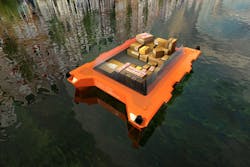Soon, Amsterdam’s canals will soon have ROBOAT floating around. These autonomous boats, developed by MIT, will investigate how urban waterways can be used to improve the city’s function and quality of life.
MIT will collaborate with the with the Amsterdam Institute for Advanced Metropolitan Solutions in the Netherlands.
The project’s aim is to develop a logistics platform for people and goods, superimposing a dynamic infrastructure over one the world’s most famous water cities. “This project imagines a fleet of autonomous boats for the transportation of goods and people that can also cooperate to produce temporary floating infrastructure, such as on-demand bridges or stages that can be assembled or disassembled in a matter of hours,” says Carlo Ratti, professor of the practice of urban technologies in the MIT Department of Urban Studies and Planning (DUSP).
In addition to infrastructure and transport, ROBOAT will also deploy environmental sensing to monitor water quality and offer data for assessing and predicting issues related to public health, pollution, and the environment.
“Water is the bearer of life. By focusing on the water system of the city, ROBOAT can create opportunities for new environmental sensing methods and climate adaptation. This will help secure the city’s quality of life and lasting functionality,” says Arjan van Timmeren, professor and scientific director at AMS.
The first prototypes of autonomous boats, or “roboats,” are expected to be tested in Amsterdam in 2017. The project’s initial phase will last for five years.
With nearly one-quarter of the city covered by water, Amsterdam is an ideal place for developing ROBOAT, according to the researchers. The canal system was once the key functional urban infrastructure of the city and today still plays a major role in recreation and tourism. Amsterdam’s waters, including bridges, canals, and the IJ river and its docks, offer plenty of opportunity to help solve current issues with transportation, mobility, and water quality.
With 80%t of global economic output generated around coasts, riverbanks, and deltas and 60% of the world population living in these areas, researchers anticipate that outcomes from the ROBOAT projects could become a reference for other urban areas around the world and a source of international entrepreneurial initiatives and start-ups in which autonomy enters the marine world.
